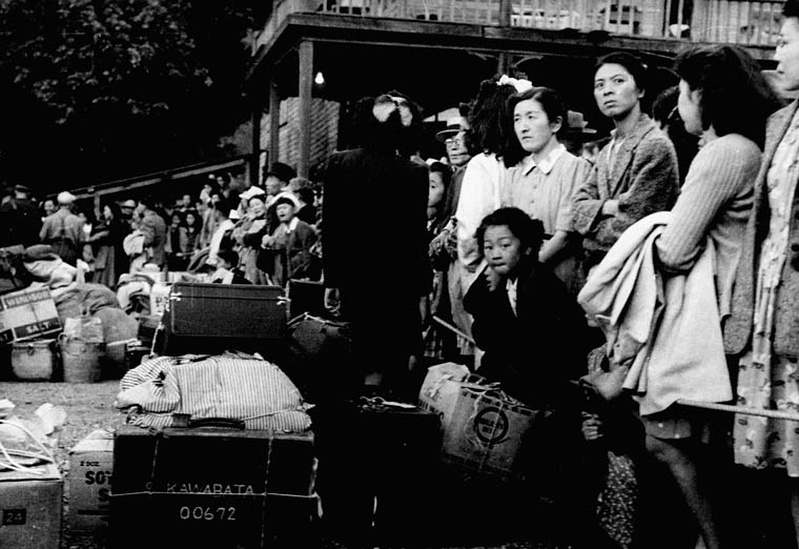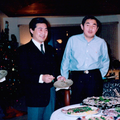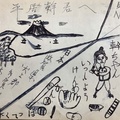The Journey to Japan and the Conditions That Awaited Them
When Canada ended its deportation policy, almost 4000 Nikkei had already been sent to Japan. 34 percent of them had Japanese citizenship (average age 51.6), 15 percent were naturalized citizens of Canada (average age 56.5), and 51 percent were Canadian-born citizens (average age 16.7) (Timmons, D.J. ‘Evangelines of 1946’: The Exile of Nikkei from Canada to Occupied Japan. MA Thesis, University of Victoria, 2011. p.70). Their lodging, food and treatment on the ships were good, although there were reports of seasickness. Upon arrival, they were processed and briefly lodged at the large repatriation centers at Uraga or Kurihama on Tokyo Bay before being sent by train to their final destinations—usually their ancestral villages.
The first shock awaiting the exiles was the devastation that was visible as they sailed past Yokohama. Soon they would see Tokyo, likewise devastated, with numerous war orphans and homeless vagrants desperately seeking shelter, and long lines waiting to receive food rations.
Another shock was the extremely poor quality of the food they received in Uraga and Kurihama (Kage, Tatsuo (transl. Kathleen Chisato Merken). Uprooted Again: Japanese Canadians Move to Japan After World War II. Victoria: TI Press, Toronto: Taijin Press, 2012. pp. 30, 104). It was stale, often moldy, and tasted so bad that the teenagers and children refused to eat it. These dismal conditions were exacerbated by high prices for any food that might be available for purchase, lack of cash due to restrictions against bringing in foreign currency, and exchange rates which greatly devalued the money they did have. These factors left them in dire financial straits. Consequently, subsequent groups of deportees were strongly advised to bring a large supply of goods, including foodstuffs and other daily necessities that would help them through this initial difficult period in Japan (Kage, 25-6).
Conditions on the trains to their ancestral villages were also deplorable. The trains were filthy and so crowded that the passengers could hardly move, and had to crawl out through the windows to even use the toilet. Passengers jostled for better position, and had to watch out for thieves who tried to steal valuables from their luggage. By the end of their train journey, many had become covered with soot (Kage 54, 62, 87).
The ‘deportees’ faced even more shocking experiences when they reached their ancestral villages. As it had been impossible during the war to make contact with anyone in Japan, upon their arrival many learned for the first time the tragic news of relatives who had been killed in the war either as soldiers or as civilians.
It also soon became clear to the ‘deportees’ that the near-famine conditions they had first noticed on their arrival at Tokyo Bay also extended to their rural agricultural villages. The large influx of demobilized soldiers and Japanese repatriates from the Japanese colonies resulted in extreme competition for the limited food and lodging. Many had to sleep in storage sheds and hastily erected temporary shelters. Hence, even here they continued to experience severe hunger and squalor. There were even some reports of elderly repatriates dying of malnutrition in the months after they returned to their villages (Kage 72, Sunahara 127). These shortages of food and shelter, combined with language problems and cultural misunderstandings also led to frictions with Japanese relatives and neighbors. Some exiles were resented because the nicer clothes they were wearing when they arrived from Canada made them appear better off than their relatives who had suffered through the war in Japan. The goods that some had brought back to share with their relatives quickly ran out, and they came to be viewed as economic burdens (Timmons 80-81). In addition, lingering wartime xenophobic attitudes sometimes led to deliberate harassment of the exiles as despised foreigners (Kage 71).
Education and Employment Problems
Education of the children was also difficult. A few, who had been sent back to Japan to receive a Japanese education and had returned to Canada before the war already spoke Japanese well and had experienced life in Japan. For them, readjusting to Japan was relatively easy. But for the majority, especially those in their teens, it was much more difficult. (Kage, 39, 43, 48).
Children under 16 were allowed to enter the Japanese school system, but most struggled with the language and had to re-start their education at a much lower level than they had already achieved in Canada. Conspicuous due to their language deficiency and the fact that they were older and taller than their classmates, they were often bullied and excluded, although some were able to turn the situation to their advantage by teaching their classmates sports they had learned in Canada (Kage 63-4, 70-1) and helping them with their English studies.
Those over 16 were not able to enter the Japanese school system, and hence found it extremely difficult to enter university. This educational barrier was a major hindrance to finding good employment, although some would later be able to use their English skills combined with effort, natural talent and social skills as a ticket to good employment with companies that would normally require a higher level of formal education (Kage 40-41).
In the immediate postwar period, many young adult exiles, thanks to their English ability, quickly found employment with the American occupation forces as maintenance workers, construction laborers, tradesmen, office workers, barbers, technicians, researchers, translators, and interpreters, etc. (Kage 33-34). They were paid relatively well and received various foodstuffs and medicines otherwise unavailable in Japan. However, most were laid off as the bases downsized following the end of the Korean War, resulting in renewed economic hardship. Some eventually found good employment with companies that needed their language skills. (Kage 48).
Attempts to Regain Canadian Citizenship
Confronted by the desperate conditions in postwar Japan, many of the young exiles immediately wanted to go back to Canada and join their friends who were still there. This was impossible because their agreement to be deported to Japan included renunciation of their Canadian citizenship. This would not be remedied until 1949 when the Canadian government finally removed restrictions on Nikkei Canadians, allowed them to return to the west coast, and gave them full citizen rights including the right to vote.
One option for those in Japan to regain Canadian citizenship was to join the Canadian army based in Japan. About 40 young men did so and trained at the Canadian base in Kure. They were highly estimated for their enthusiasm, and many of them fought for Canada in the Korean war. Some women exiles married members of American, Canadian and other armed forces stationed in Japan and in this way were able to leave Japan. (Timmons 86).
Why Some Stayed Permanently in Japan
Despite the terrible conditions in postwar Japan and the initial desire of most young exiles to return to Canada, many ended up staying permanently in Japan. While there are no reliable statistics, it is generally estimated that only about half eventually returned to Canada (Kage, 20). This raises the question as to why the other half did not, but instead settled permanently in Japan.
Kage asked several exiles living in Japan about their reasons for remaining there. He received a variety of answers which often included a combination of factors. One of the most common reasons was marriage to a Japanese spouse and having children in Japan. Another was that, due to their English skill, they were able to find a good career path in Japan that they came to enjoy and did not want to relinquish. Another reason given by some was that, over time, they had come to feel secure and comfortable in Japan, even if they had not completely assimilated to the culture. A few said that, due to their bitter memories of the unjust treatment they had received from the Canadian government during the war, they felt too much resentment towards Canada to ever want to return, although this resentment dissipated with time for some (Kage 74-76).
* This series is an abridged version of a paper titled, “Life Histories of Japanese Canadian Deportees: A father and son case history”, first published in The Journal of the Institute for Language and Culture (Konan University), March 15 2017, pp. 3-42.
© 2018 Stanley Kirk







